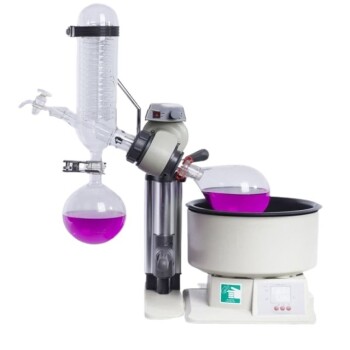Rotary evaporation and liquid-liquid extraction are closely related processes in chemistry and laboratory workflows, particularly in the separation and purification of compounds. Rotary evaporation is a technique used to remove solvents from samples, often following liquid-liquid extraction, which separates compounds based on their solubilities in different solvents. Rotary evaporation enhances the efficiency of liquid-liquid extraction by enabling the recovery of solvents and the concentration of target compounds under controlled conditions. This relationship is critical for applications such as plant extraction, where heat-sensitive compounds like cannabinoids, flavonoids, and terpenes must be preserved. The process leverages reduced pressure and controlled temperatures to prevent degradation, suppress bumping, and improve yields, making it a preferred method for post-extraction solvent removal.
Key Points Explained:

-
Relationship Between Rotary Evaporation and Liquid-Liquid Extraction:
- Liquid-liquid extraction separates compounds based on their solubilities in two immiscible solvents.
- Rotary evaporation is often used after liquid-liquid extraction to remove the solvent from the extracted compounds.
- The combination of these processes ensures efficient separation and concentration of target compounds.
-
How Rotary Evaporation Works:
- The process involves reducing pressure using a vacuum pump, which lowers the boiling point of the solvent.
- A rotating flask creates a thin film of the sample, increasing the surface area for evaporation.
- The solvent evaporates at lower temperatures, condenses in a cooled condenser, and is collected in a distillate flask.
-
Advantages of Rotary Evaporation in Liquid-Liquid Extraction:
- Lower Temperatures: Prevents degradation of heat-sensitive compounds, such as cannabinoids and terpenes.
- Suppression of Bumping: Adjusting the vacuum reduces the risk of solvent splashing, which can damage equipment or reduce yields.
- Continuous and Automated Process: Enhances efficiency and reduces labor compared to traditional methods like maceration.
- Solvent Reusability: The recovered solvent can be reused, making the process more economical and environmentally friendly.
-
Applications in Plant Extraction:
- Rotary evaporation is particularly effective for extracting compounds from plants, such as cannabis.
- It preserves desirable compounds like cannabinoids, flavonoids, and terpenes while removing unwanted lipids and waxes.
- The process is used to produce concentrated extracts, such as shatter and THCA, which are rich in active compounds.
-
Design and Efficiency:
- The rotary evaporator's design utilizes frictional and centrifugal forces to create a thin film of the extract, maximizing evaporation surface area.
- This design minimizes mechanical damage and improves yields by reducing bumping and ensuring uniform heating.
-
Practical Considerations for Equipment Purchasers:
- When selecting a rotary evaporator for liquid-liquid extraction, consider factors like temperature control, vacuum efficiency, and flask capacity.
- Look for features such as automated vacuum adjustment, corrosion-resistant materials, and compatibility with a wide range of solvents.
- Ensure the system is scalable for your laboratory's needs, whether for small-scale research or large-scale production.
By integrating rotary evaporation with liquid-liquid extraction, laboratories can achieve higher purity, better yields, and more efficient workflows, making it an essential technique for applications ranging from pharmaceutical research to plant extraction.
Summary Table:
| Aspect | Details |
|---|---|
| Relationship | Rotary evaporation follows liquid-liquid extraction for solvent removal. |
| Key Advantages | Lower temperatures, bumping suppression, solvent reusability, automation. |
| Applications | Plant extraction (e.g., cannabinoids, terpenes), pharmaceutical research. |
| Equipment Considerations | Temperature control, vacuum efficiency, corrosion resistance, scalability. |
Optimize your lab's extraction process with rotary evaporation—contact us today for expert advice!










